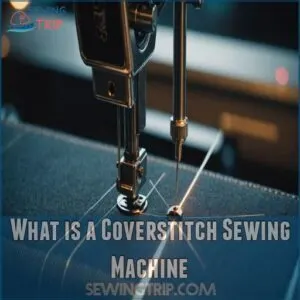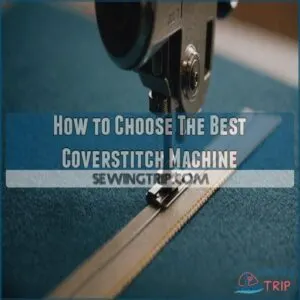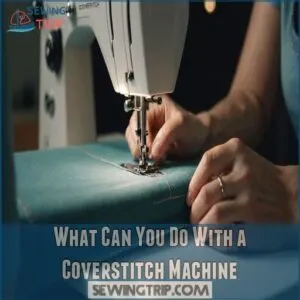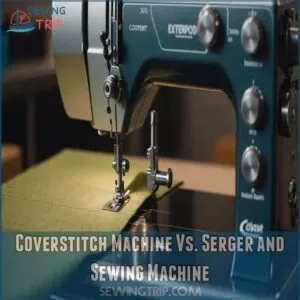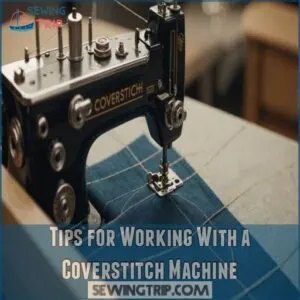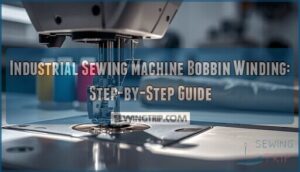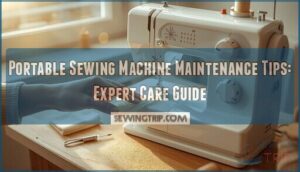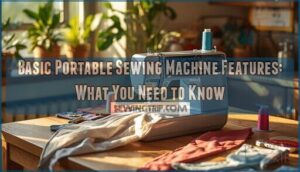This site is supported by our readers. We may earn a commission, at no cost to you, if you purchase through links.
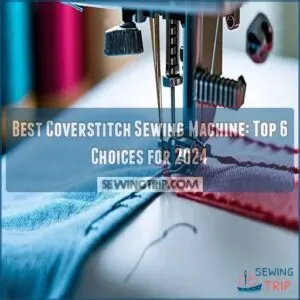
The Juki MO 735, with its 24 stitch options and ability to handle a wide range of fabrics, is a powerhouse.
If you’re after something affordable and durable, the Brother Coverstitch Serger 2340CV might tick your boxes.
Looking for speed and ease? The Janome Cover Pro 1000CPX offers up to 1,000 stitches per minute.
Each machine brings its own flair.
Fancy a closer look at how these machines can transform your sewing game? Keep reading!
Table Of Contents
- Key Takeaways
- What is a Coverstitch Sewing Machine
- How to Choose The Best Coverstitch Machine
- Top 6 Best Coverstitch Sewing Machines
- What Can You Do With a Coverstitch Machine
- Coverstitch Machine Vs. Serger and Sewing Machine
- Tips for Working With a Coverstitch Machine
- Frequently Asked Questions (FAQs)
- Conclusion
Key Takeaways
- You can choose a coverstitch machine based on your needs, like the Juki MO 735 for versatility or the Brother 2340CV for affordability.
- A coverstitch machine offers professional-looking hems and seams, especially on stretchy fabrics, enhancing the finish of your projects.
- Consider important features like stitching speed, ease of use, and durability to find a machine that suits your sewing style.
- Don’t overlook support and warranties; they provide peace of mind and assistance in case of technical issues with your machine.
What is a Coverstitch Sewing Machine
Ever wondered how those perfect hems on your store-bought clothes stay neat and stretchy?
A coverstitch sewing machine is your secret weapon for crafting professional-looking hems, seams, and topstitches.
Making your DIY projects stand out with ease.
Key Features of a Coverstitch Machine
Ever wondered what makes a coverstitch machine special?
It’s the secret weapon for excellent garment finishes.
Here’s why:
- Stitch Quality: Achieve stretchy, durable seams.
- Threading Ease: Simplifies setup, saves time.
- Differential Feed: Prevents wavy hems, keeps fabrics in shape.
A must-have for sewing enthusiasts who value precision!
Benefits of Using a Coverstitch Machine
For perfecting your sewing projects, a coverstitch sewing machine is your trusty sidekick.
It creates professional hems and durable seams on stretch fabrics, giving your garments a polished look.
Unlike using a serger machine or twin-needle stitching, the coverstitch neatly handles knit fabrics, ensuring a professional finish.
Plus, its topstitching detail takes clothing finishing to the next level.
Types of Coverstitch Machines
Imagine exploring coverstitch machines, where you’ve got options like two-needle, three-needle, and the versatile serger/coverstitch combo, which can provide benefits like those of a serger for garment construction.
Two-needle machines handle a double coverstitch, while three-needle models add a triple stitch for more stretch.
Some machines, even more cleverly, combine overlock stitch capabilities, offering both versatility and efficient stitch width adjustments.
How to Choose The Best Coverstitch Machine
Choosing the right coverstitch machine can feel overwhelming, but don’t worry!
We’ll walk you through the key features to look at, like stitch speed, thread options, and warranty, so you can find the perfect machine for your sewing needs.
Important Features to Consider
Choosing the best coverstitch machine boils down to a few key features.
Look for:
- Stitch quality: It’s important for professional finishes.
- Ease of use: This guarantees a smooth sewing experience.
- Adjustable presser foot pressure: Essential for handling various fabrics.
Also, consider durability and affordability to keep your sewing projects on track without heavyweight frustrations.
Stitching Speed and Thread Options
Matching a coverstitch machine to your needs involves checking stitching speed and thread options.
You want a machine like the Juki MCS-1500 with top speeds of 1350 stitches per minute.
Consider thread types: serger threads for strength, wooly nylon for stretchy seams, and tension control for consistent stitch quality.
It’s like finding the perfect recipe for sewing success!
Size, Weight, and Noise Level
While considering stitching speed and thread options, think about size, weight, and noise level too.
A compact vs. large sewing machine impacts space, while weight affects portability.
- Machine Weight Impact: Heavy-duty machines may feel sturdy but are tough to move.
- Noise Level Comparison: Quiet sewing options enhance peace.
- Compact vs. Large: Choose according to your space.
- Buying Guide: Align with needs for the best choice.
Guarantees and Customer Support
After considering size and noise level, remember to check guarantees and customer support for coverstitch machines.
Look for a solid warranty length; repair costs can sneak up if you’re not careful.
Dig into customer reviews for insights.
Online resources and phone support should be readily available.
A good coverstitch machine will keep you happily stitching away.
Top 6 Best Coverstitch Sewing Machines
When you’re in the market for a coverstitch sewing machine, narrowing down the top choices can feel like hunting for treasure.
We’ve sifted through the options and are presenting you with the top six machines of 2024, each offering unique features to enhance your sewing projects.
Each machine offers unique features to enhance your sewing projects without sewing your wallet shut.
1. Juki MO 735 Serger Cover Hem Machine
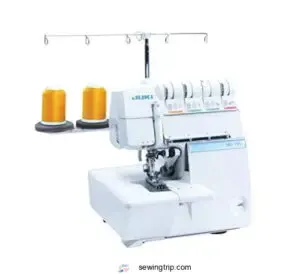
The Juki MO 735 Serger Cover Hem Machine packs quite a punch with its 24 stitch options, making almost any sewing project a breeze.
You’ll appreciate its versatility, handling everything from lightweight to heavyweight fabrics with ease.
The machine features a 2- and 3-needle coverstitch, perfect for creating professional-looking hems on knit garments.
While threading might be challenging, helpful YouTube videos are available.
Whether you fancy making trendy sportswear or cozy kids’ clothing, the Juki MO 735 has you covered!
Best For: The Juki MO 735 is best for experienced sewers who want a powerful machine for a variety of projects.
- 24 stitch options for versatility
- Handles a wide range of fabrics
- Powerful and fast
- Threading can be challenging
- Instructions are difficult to understand
- Some reports of needles coming unglued
2. Brother Coverstitch Serger 2340CV
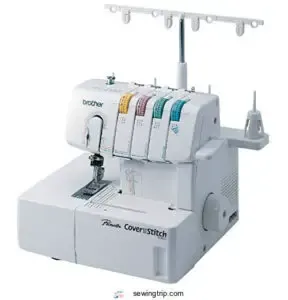
A great entry-level option, the Brother 2340CV cover stitch machine offers versatility.
You’ll find it handles 2-3-4 thread cover stitches, plus a chain stitch.
It’s known for its good stitch quality when properly set up, but be prepared for a learning curve; some users report initial difficulties (Source).
Despite this, its affordability and the availability of online tutorials make it a popular choice.
Remember, mastering this machine gives you control over professional-looking hems and decorative stitching.
Consider it if you’re on a budget but want quality results.
Best For: The Brother 2340CV is best for beginner sewers wanting to try cover stitching on a budget.
- Versatile stitch options for different projects.
- Durable construction for long-term use.
- Affordable price point for an entry-level machine.
- Potential for thread breakage, especially in the left needle.
- No auto threading or LED lights.
- Requires some setup and learning to achieve optimal results.
3. Juki MCS 1500 Cover Stitch Machine
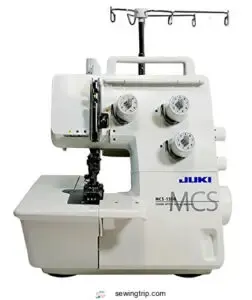
Imagine sewing with ease using the Juki MCS 1500 Cover Stitch Machine, your trusty sidekick for professional finishes.
This powerhouse handles a variety of fabrics, from knits to wovens, with its 3- and 4-thread capabilities.
Changing from one project to another is a breeze, thanks to its quick looper threading and adjustable stitch settings .
Zipping through at 1,350 stitches per minute, it’s like having a sewing gym session—smooth, efficient, and surprisingly quiet.
Best For: The Juki MCS 1500 Cover Stitch Machine is best for sewers who want a fast, easy-to-use machine that can handle a variety of fabrics.
- Creates professional-looking finishes.
- Handles a variety of fabrics with its 3- and 4-thread capabilities.
- Sewing at 1,350 stitches per minute, it’s a fast and efficient machine.
- Some users found initial threading difficult.
- Limited YouTube videos are available.
- Facebook groups for this specific machine may be limited.
4. CoverPro 900CPX Coverstitch Machine
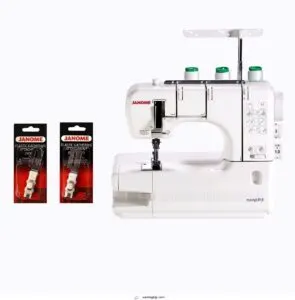
Meet the CoverPro 900CPX, your new sewing sidekick.
It’s an industrial-style cover hem machine that feels right at home in your sewing room.
This gizmo is high-speed, yet smooth as butter, though it occasionally skips stitches.
Beginners will breeze through threading, but brace yourself for some quirky instructions on YouTube.
If thick seams are your nemesis, this machine might give you trouble unless hem tape becomes your best friend.
It’s a robust choice, offering freedom with a professional finish.
Best For: The Janome CoverPro 900CPX is best for sewers who need a high-speed, industrial-style cover hem machine with a home sewing machine feel.
- Easy to thread, making it beginner-friendly.
- Produces professional-looking coverstitch results.
- Smooth and quiet operation.
- May skip stitches, especially over thick seams.
- May require hem tape to prevent skipping stitches over thick seams.
- Lacks a metal plate for adding attachments.
5. Brother Cover Stitch Machine White
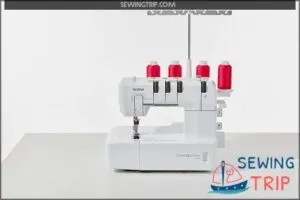
Looking for a solid coverstitch machine?
The Brother Cover Stitch Machine White might catch your eye.
With its large workspace and one-touch tension release, it makes sewing feel like a breeze.
You’ll love the color-coded threading system, perfect for keeping things straight when working with different fabrics like knits and fleece.
This machine does have a learning curve, especially with stretchy knits, but once you get the hang of it, you’ll enjoy professional-looking hems and decorative stitches.
It’s also a great choice for those looking for a serger with adjustable stitch width, such as the Brother DZ1234 serger, which offers a range from 3-7mm. This machine is best for home sewers who want to create professional-looking hems and decorative stitches on a variety of fabrics, especially thicker fabrics like knits and fleece.
- Easy to thread and use.
- Large workspace is beneficial.
- Produces professional-looking stitches.
- Difficult to use with stretchy lightweight knits.
- Can chew fabric if not used correctly.
- Requires practice to master.
6. Janome Cover Pro 1000CPX Coverstitch Machine
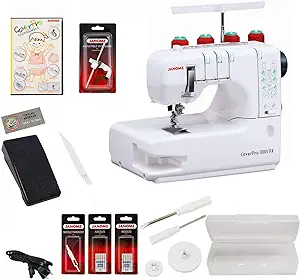
As you explore sewing with the Janome Cover Pro 1000CPX, you’ll appreciate its straightforward design for professional finishes.
This machine offers three needle options, speed up to 1,000 stitches per minute, and a differential feed, providing reliable stitching on various fabrics.
Users mention its ease of threading and versatility, although some find the noise level a bit bothersome.
The large work bed and free arm let you handle sleeves effortlessly, encouraging creative freedom in your sewing projects.
Best For: The Janome Cover Pro 1000CPX is best for sewers who need a dedicated coverstitch machine for projects requiring a professional finish.
- Offers three needle options for various cover stitch widths.
- Features a large work bed and a free arm for easy handling of sleeves and other garment parts.
- Includes a differential feed for reliable stitching on a variety of fabrics.
- Some users report issues with tunneling, especially on lightweight knits.
- Some users find the machine’s noise level to be bothersome.
- The machine is an older design and may require some extra troubleshooting.
What Can You Do With a Coverstitch Machine
With a coverstitch machine, you can create professional-looking hems and seams that add a polished finish to any garment and tackle stretchy fabrics like a pro without breaking a sweat.
With the help of coverstitch sergers, such as the Brother Coverstitch Serger for professional hems, decorative stitches and topstitching allow you to discover new creative potential, making it easy to elevate your sewing projects to new heights.
Professional-Looking Hems and Seams
Get started with garment sewing using a coverstitch machine to achieve professional-looking hems and seams!
This marvel handles stretchy and knit fabrics with ease, using techniques like the best stitch for stretchy fabric, offering seamless finishes that amaze.
Imagine turning out garments that look straight from a boutique.
With coverstitch basics, you’ll master hemming techniques and seam finishes in no time, making every piece ready for the runway.
Decorative Stitches and Topstitching
A coverstitch machine isn’t just for hems; it’s your secret weapon for awesome topstitching!
Experiment with different stitch patterns and thread colors for unique embellishment ideas.
Master coverstitch techniques like the chain stitch for decorative effects (Source).
The free arm helps with curves, creating beautiful topstitching styles on pockets and cuffs.
Expand your creativity with varied thread choices and explore the possibilities!
Sewing Stretchy and Delicate Fabrics
After perfecting your decorative stitches, you can use a serger with coverstitch to hem knits professionally in one step learn more about sergers with coverstitch. You can confidently tackle stretchy and delicate fabrics using a coverstitch sewing machine.
It’s all about fabric tension and selecting the right needle, as well as mastering coverstitch basics.
Adjust the presser foot for a feather-light touch on delicate materials.
Explore different stitch types to finish seams flawlessly.
With these techniques, even the trickiest fabrics won’t stand a chance.
Creating Professional-Quality Garments
You’ve mastered stretchy fabrics; now, elevate your sewing game by creating professional-quality garments with a coverstitch machine.
This gem lets you:
- Tackle finishing techniques that shout "expert."
- Perfect garment construction with smooth seams.
This gem lets you:
- Nail the right fabric choice for a polished look.
- Enhance pattern selection, giving every project a runway-ready finish.
Coverstitch Machine Vs. Serger and Sewing Machine
You’re not alone if you’re scratching your head over the differences between coverstitch machines, sergers, and sewing machines.
Each type has its unique strengths, so let’s break down what each one can do for your sewing projects.
Key Differences and Similarities
You’re not alone if you’re pondering the differences between coverstitch machines, sergers, and sewing machines.
Coverstitch vs. serger—it’s as much about stitch types as user experience.
While coverstitch machines like the Janome Coverpro 900CPX handle hems, sergers trim fabric.
Here’s a quick comparison:
| Feature | Coverstitch Machine |
|---|---|
| Trimming | No |
| Hems | Yes |
| Multi-thread | Yes |
| Speed | Faster than sewing machines |
Each machine has its niche.
Benefits of Each Type of Machine
Exploring these unique machines reveals diverse benefits.
A coverstitch machine enhances stitch quality on stretchy fabrics, offering you professional-grade performance at home—perfect for hemming challenging fabrics like knits.
Meanwhile, a serger takes on seam finishing with ease, adding a polished touch to projects.
A sewing machine, with its budget-friendly options, remains versatile for all fabric types and beginners.
Choosing The Right Machine for Your Needs
When choosing the right machine, think about your budget, fabric types, and sewing experience.
A coverstitch machine like the Janome 1000CPX excels with stretchy fabrics, while sergers trim edges neatly.
Consider these points:
- Budget: Can you afford more?
- Warranty: Is it covered?
- Machine Features: What’s essential for you?
- Experience: How much do you have?
Tips for Working With a Coverstitch Machine
Mastering your coverstitch machine is easier than you think! We’ll cover threading, adjusting settings, and fixing common problems so you can create professional-looking seams with confidence.
Threading and Setting Up Your Machine
Mastering your coverstitch sewing machine starts with understanding the strongest stitch types, like the straight stitch which is the most durable stitch on a sewing machine. Mastering your coverstitch sewing machine starts with threading basics.
Carefully tackle the looper setup to avoid tangled threads, ensuring smooth operation.
Adjust tension for crisp, reliable stitches, and select the right needle to prevent skipped stitches.
If issues arise, troubleshoot by rechecking your setup step-by-step.
With practice, you’ll be zipping through projects like a pro, effortlessly sewing perfect hems!
Adjusting Stitch Length and Width
You’ve got the machine threaded, now fine-tune your stitching. Adjusting stitch width and length on a versatile machine like the Brother CS6000i requires understanding how stitch formation is affected by fabric choice and thread tension. Adjusting stitch length and width on your coverstitch sewing machine:
- Set stitch length longer for stretchy fabrics; shorter for thicker ones.
- Choose wider stitches for durability or narrower for a sleek finish.
- Experiment with different combinations to find the perfect stitch and accomplish hem adjustments like a pro. Happy sewing!
Troubleshooting Common Issues
Encountering issues with your coverstitch sewing machine? Adjust thread tension to fix skipped stitches.
For needle problems, try using brand-specific needles like those recommended for Brother 2340cv or Janome CoverPro 1000cpx.
Also, for machine embroidery projects, checking machine embroidery troubleshooting can help identify common issues such as puckering, looping, and alignment challenges.
Troubleshoot fabric jamming by ensuring proper threading.
If noise issues persist, clean around Singer Professional 14t968dc or Consew 14TU858 machines regularly.
| Issue | Cause | Solution |
|---|---|---|
| Skipped Stitches | Wrong tension | Adjust thread tension |
| Needle Problems | Improper needles | Use recommended needles |
| Fabric Jamming | Poor threading | Re-thread machine correctly |
Frequently Asked Questions (FAQs)
Which sewing machine has the best coverstitch capability?
For excellent coverstitch capability, consider the Brother CV
It offers easy threading, a top-cover stitch option, and great accessory availability.
This makes it suitable for both beginners and experienced sewists tackling various projects.
Which coverstitch machine do you use?
Imagine this: a sewing machine superhero! I personally use the Brother CV3550; it’s versatile, easy to thread, and handles various projects like a champ. You’ll love its top-cover stitch option!
Which sewing threads are suitable for coverstitch machines?
You’ll want to use regular polyester thread or serger thread for coverstitch machines.
Try brands like Gutermann, Coats & Clark, or Maxi-Lock.
For loopers, a wooly nylon thread can also provide great elasticity and coverage.
What is a coverstitch sewing machine?
Ever wonder how t-shirts get those neat stretchy hems?
A coverstitch sewing machine makes it happen by using a chain-style stitch perfect for knits.
It’s your go-to for professional finishes on stretchy fabrics and activewear.
What is the difference between brother CV3440 and CV3550?
The Brother CV3440 has basic cover stitch options.
The CV3550 adds double-sided cover stitches for an enhanced professional look.
It offers additional stitch options by using a top cover stitch for versatile sewing projects (Source).
What is the alternative to a coverstitch machine?
Consider using a twin needle on a regular sewing machine as a cost-effective alternative to a coverstitch machine.
It creates a similar look, offers decent stretch, and only requires an extra thread spool.
Can I do a coverstitch on my sewing machine?
Yes, you can achieve a coverstitch look on your sewing machine by using a twin needle.
Just switch to a stretch twin needle.
And make sure you have an extra spool pin for threading.
Should I buy a serger or coverstitch?
Imagine this: hemming those tricky knits effortlessly.
If space and budget allow, grab both machines for ultimate versatility.
A serger finishes seams beautifully, while a coverstitch perfects hems and topstitching tasks splendidly.
How does a coverstitch machine improve garment finishing?
It creates professional-looking hems and finishes, especially on knits. You’ll achieve a clean, flat edge, unlike other methods. Plus, it adds that extra touch of quality!
What maintenance does a coverstitch machine require?
To keep your coverstitch machine humming like a trusty sidekick, regularly clean out fluff, oil metal parts sparingly, and make sure thread tension is adjusted.
Check your manual for specific oiling points; it makes a world of difference.
Can a coverstitch machine handle heavy fabrics?
Did you know some coverstitch machines handle up to 15 layers of fabric?
Yes, you can tackle heavy fabrics like denim by adjusting tension and using a robust needle.
It’s like conquering a sewing challenge with flair.
Are there portable coverstitch machine options?
You’ve got options for portable coverstitch machines.
Models like the Brother CV3550 and the Janome CoverPro 1000CPX are favored for their versatility and compact design.
They are suitable for home or travel use.
How does threading a coverstitch machine work?
Threading a coverstitch machine feels like solving a puzzle, but it’s easier than a serger.
Simply follow the thread guides, starting with the looper, then the needles.
Remember to adjust tension as needed for perfect stitches.
Conclusion
On your hunt for the best coverstitch sewing machine, remember that 75% of professional sewists consider stitch versatility a top priority.
Whether you choose the speed of the Janome Cover Pro 1000CPX or the affordability of the Brother Coverstitch Serger 2340CV, you’ll elevate your sewing projects greatly.
Each machine offers unique strengths, from handling stretchy fabrics to creating professional-quality hems.
So, get ready to transform your creative ideas into reality and enjoy every stitch of the way!

